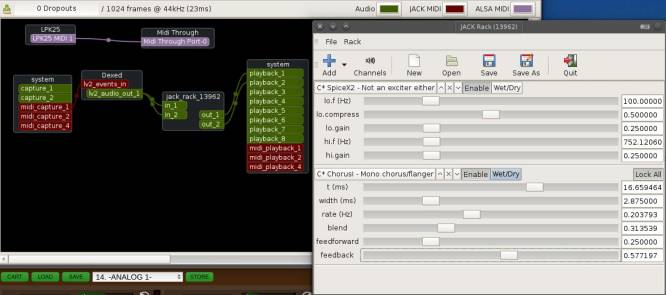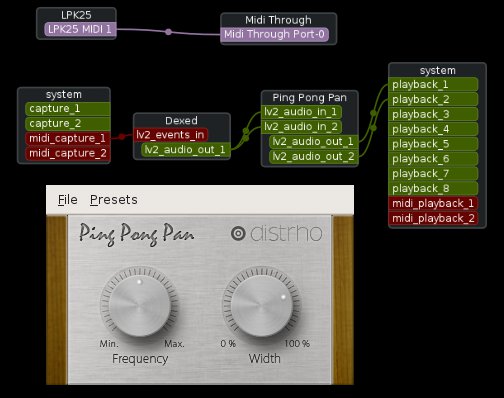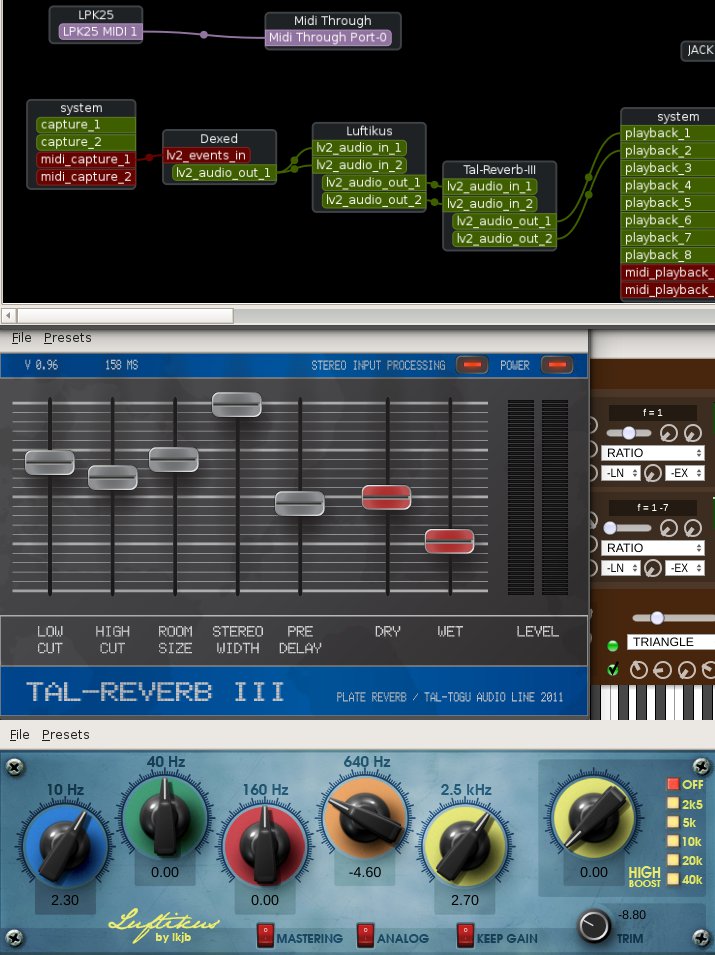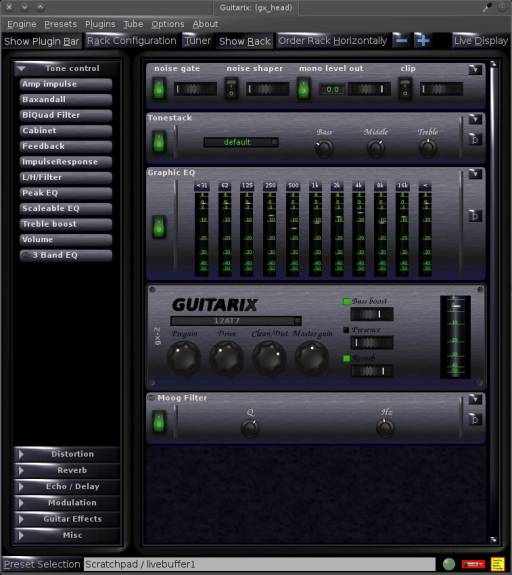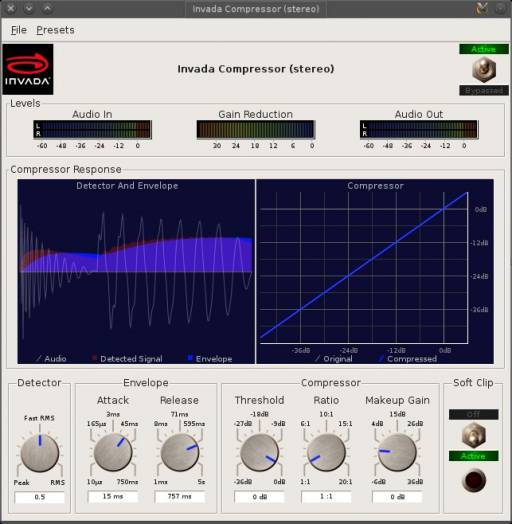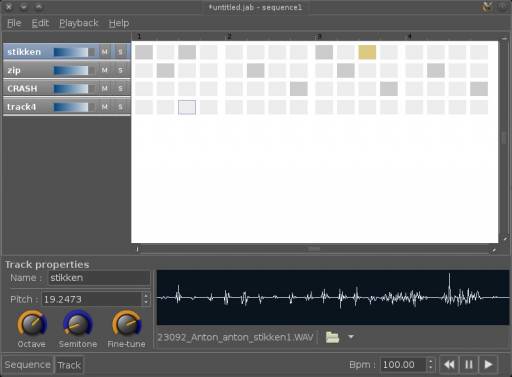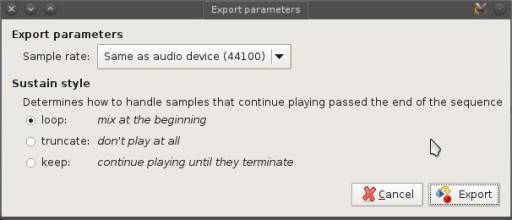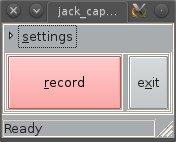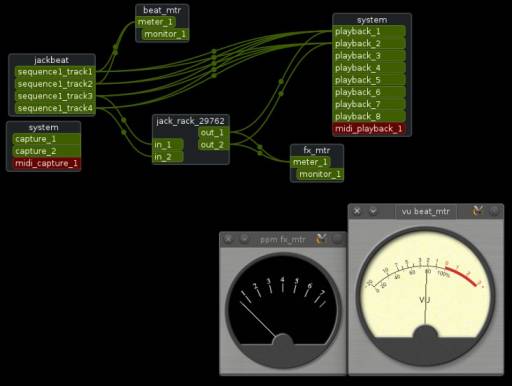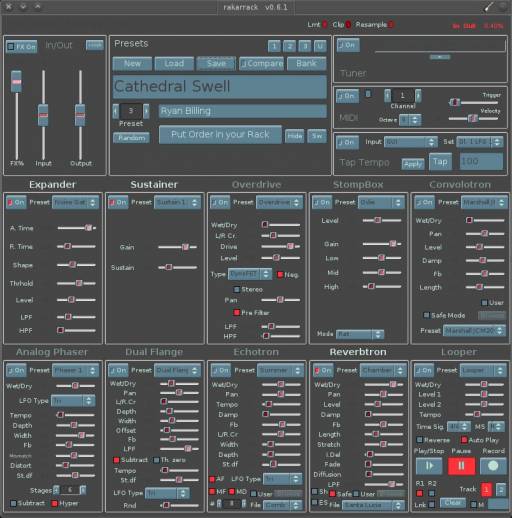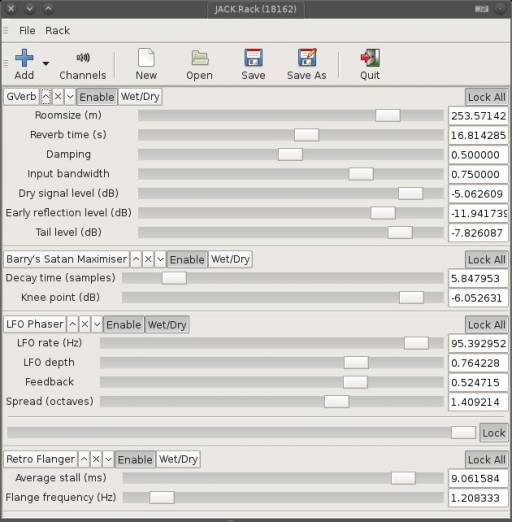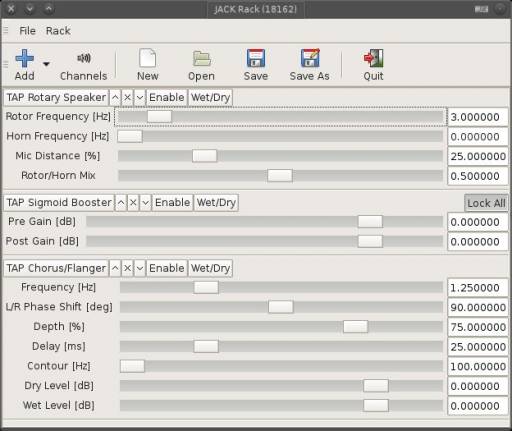Audio Effects & Filters
Open source creativity is very prolific; this section contains a small sample of the applications available for a modular studio, and is only curated by a tool's stability and reliability.
With JACK, all applications can be channeled through a single system, whether the application was designed as a stand-alone application or as a plugin. This blurs the line between what it means to be a stand-alone application or a plugin, and that's a powerful level of flexibility that simply does not exist in closed systems.
There are three native, free plugin formats for Linux Audio: DSSI, LADSPA, and LADSPA version 2. In this section, each tool is marked with an icon:
- A Stand-alone application
None of these are exclusive to the others.
Stand-Alone, Hosting, Plugins
There are three different ways to run many (not all) JACK-aware applications. There is no “right” or “wrong” way; it depends on what the project needs and what your style of working is. Your choices are:
Plugins to larger JACK applications
Usually, it's best to run an filter or effect as a DSSI, LADSPA, or LV2 plugin, if possible; the host application (usually a DAW) handles all of the filter settings and is able to unobtrusively spawn a unique instance of the filter on a per-track basis.
Stand-alone application
Sometimes it isn't possible to run something as a plugin, or you prefer not to run it that way. In some cases, a filter can be launched as a stand-alone application, integrated into your audio pipeline through JACK. In this model, all settings (banks, patches, tweaks, levels, and so on) are maintained by you, the user. This means you have to keep track of saved settings (it helps to use a project manager like Slackermedia's Planter) and JACK routes (see aj-snapshot).
Hosted JACK application
If you cannot run the application as a stand-alone application, there is probably a JACK host (such as Jack-Rack, Calf JACK Host, or jack-dssi-host) which can act as a non-DAW into which the plugin can be loaded and used. The settings (banks, patches, levels, and so on) are maintained by the host application, but independent of any DAW you might be using, so you still have to keep track of the saved session files of whatever host you are using.
Calf Jack Host
Host rack for Calf plugins. See Calf.
CAPS
L
CAPS is a collection of audio plugins comprising basic virtual guitar amplification and a small range of classic effects, signal processors and generators of mostly elementary and occasionally exotic nature.
Install them from http://slackbuilds.org, and find them listed with your LADSPA plugins in your DAW or Jack Rack as C* Audio Plugins.
Disthro Mini Series
V
A small collection minor (but useful) plugins written by the tireless maintainer of the KXStudio multimedia distribution. The pack consists of:
- Ping Pong Pan
- 3-Band EQ
- 3-Band Splitter
Disthro Ports
V
Disthro Ports is a collection of “ported” applications (meaning that the author of the LV2 plugins did not write the code, but made it compatible with Linux in an LV2 wrapping). This is a mixed bag, full of mostly small plugins that probably don't qualify as “must have” effects at first glance, but can make all the difference when you need something a bit niche or unique.
This collection currently includes:
- Artican The Pilgrim
- Artican The Function
- Dexed DX7 Emulator
- dRowAudio plugins
- Easy Sound Space Perception
- Juced Plugins
- KlangFalter convolution (requires impulse responses)
- LUFS Meter
- Luftikus EQ
- Mverb reverb
- Nekobi TB-303 inspired drum sequencer
- Obxd Obx (and family) emulator
- Pitched Delay
- Stereo Source Separator
- TAL Dub-3, Filter, NoiseMaker, Reverb, and Vocoder
- Vex 3-oscillator subtractive waverom synth
- Wolpertinger subtractive, antialiased polyphonic software synthesizer
DSSI Jack Host
Jack host for DSSI plugins. See DSSI Jack Host.
Guitarix
S L
Guitarix is intended for on-the-fly, live performances. It is not intended to be a longterm effects unit to be incorporated into your projects. You have been warned.
As such, Guitarix is a mono amp designed for, as its name implies, guitars; it even has controls for tube amp emulation. Like rakarrack, it is not modular in the sense that JACK only sees one input to it, so all sound fed to Guitarix goes through all active Guitarix effects, so it's probably an effect unit you will use mostly on a per-instrument basis.
The Guitarix developers warn “Guitarix is evolving, and so are the Guitarix LADSPA plugins. This means you cannot add them to a DAW track, wait a year, install the then current version and expect it to work (or have the same sound).”
A unique feature of Guitarix is an inbuilt recording unit (a little like JACK capture), so if you are jamming and want to record, that capability is available as part of your rack.
There are a few different views into your Guitarix window. The default is a basic single-column rack, but clicking the Show Plugin Bar button in the top toolbar reveals a list of available plugins in a panel on the left of the window. click the Order Rack Horizonally button in the top toolbar to show a two-column view of your rack.
If you have Meterbridge installed, launch meters for your effects from the Options menu → Meterbridge.
Save your Guitarix sessions in the Presets menu. Do this for each guitarix instance of each project.
Invada
V
The Invada plugins are a series of high quality audio plugins that contain all the basic filters you need in a studio. This is not an everything-and-the-kitchen-sink collection of “fun” filters for the sake of experimentation, this is a serious, stable, and effective set of filters.
Jack Beat
S
Jackbeat is a stand-alone sequencer for JACK. With it, you can queue up samples, loops, and beats and play it in sync with the rest of your JACK studio.
Install Jackbeat from StudioWare.
Using Jackbeat is fairly intuitive. Load a sample using the track panel properties or the Edit menu. Toggle with a click (or b on your keyboard) the cells in the grid workspace to sequence the sounds.
Navigation within the grid workspace can be keyboard driven (use the arrow keys), or you can use the mouse.
Increase the size of your workspace with the Double function, in the Edit menu.
Use Shift Click (or press N on your keyboard) to toggle a “mask” (or “negation”) for any given beat. This mutes the track during the duration of that beat.
Exporting the Loop
Jack Beat has no song editor; it creates one pattern, looped endlessly. You can either create very long patterns and just compose music in jack beat (you probably do not want to do that), or you can export the loops, as wav files, that you create incrementally for use in a proper sequencer.
Jack Beat doesn't just do a play-through export; its default behaviour is to blend the in and out points of your loop so that playing it back is seamless.
Jack Capture
S
Jack Capture is a recorder for whatever is streaming to the System Out JACK port. This means that you can record improv or sequenced pieces on the fly; it's the Master Out for your modular studio.
There is no configuration required; Jack Capture attaches itself to the master output of JACK no matter what.
Jack Capture handles its own settings (not its routing), and there isn't much to be set; choose the file format and bitrate, and Jack Capture will maintain its settings across sessions.
Jack Keyboard
S
MIDI controllers with USB connections are common and easy to use, but if you do not have one or do not have one handy, then a virtual keyboard is useful.
Jack Keyboard provides exactly what you would expect; it displays a keyboard onscreen that you can use when sequencing notes.
After launching Jack Keyboard, connect it to a MIDI port from the Connected to dropdown menu at the top left.
JACK Rack
Host rack for LADSPA plugins. See Jack Rack.
Jalv
Jack host for LV2 plugins. See Jalv.
Jamin
Audio mastering suite. See Jamin.
Meter Bridge and Jack_Meter
S
Monitoring your sound can be done with meterbridge, or even in a unix shell with jack_meter.
Both attach to a JACK output and display the decibel level of its sound.
Since Jack Capture does not have a monitoring tool itself, a separate monitor like Meterbridge or Jackmeter is essential.
They have no settings as such, but the connection to a meter is recorded along with the overall JACK session recorded with a tool such as aj-snapshot.
Non
A modular studio for your modular studio; session management, sequencing, and mixing all in distinct executables.
See Non.
Rakarrack
S
Rakarrack is intended as a guitar effect box and models itself, more or less, after an all-in-one stomp box. As such, it is not terribly modular in itself (any effect that is activated in one Rakarrack instance is automatically chained to the other active effects in the same Rakarrack instance), but that doesn't mean you can't have multiple Rakarrack instances if you want them.
The effect quality is very high, and all the essentials are present; reverbs, echo, chorus, phaser, flanger, EQ, and more.
Rakarrack is configurable in many ways, including its theme, so you are free to change it to suit your own style.
Save settings for a Rakarrack instance with the Save button at the top of the window. Do this for each instance in each project. As with many modular Linux tools, you can launch Rakarrack from a shell such that its pre-set is automatically loaded, and you can even launch it without a GUI if you don't have any need to modify settings.
Steve Harris LADSPA Plugins
L
The Steve Harris LADSPA plugins are innumerable, an amazing feat of mass production for maximum variety. Being LADSPA version 1, they are not the prettiest plugins to look at:
And they aren't always the most useful, or the most stable. There are so many to choose from that you're bound to find and fall in love with at least a few effects that you suddenly will find yourself unable to live without. But take care when trying new ones; audition them and learn what they do, whether it is stable, and whether your computer can handle the values you are dialing in.
TAP
L
The TAP plugins are a set of basic LADSPA plugin effects. It's something of a mixed bag, with, for instance, a reverb that is not realtime capable (fine for Audacity but not great for anything else). It is a stable set, however, and worth installing for those small but essential plugins.
Synths
If it's synths you love, you'll never run out of knobs, dials, and switches to play with on Linux. There are so many ways to generate, shape, and transform sound that you may just give up writing music in favour of writing synth patches.
There are far too many free soft synths out there to cover them all, but a list of a few interesting ones is available in the Synths section.
And Much Much More
This list is not exhaustive and it is, at best, a loose collection of tools that should not be listed together in the first place. Each of the tools listed in this section are unique and independent, and they can be used with DAWs just as easily as with a completely modular setup.
The purpose of this list has only been to highlight a few of the great tools you have available, not to suggest a correlation between any of them, or even to suggest a workflow binding them all together.
Try the tools out, chain them together in whatever way you see fit, and embrace the chaos (or impose strict order; it's up to you).
